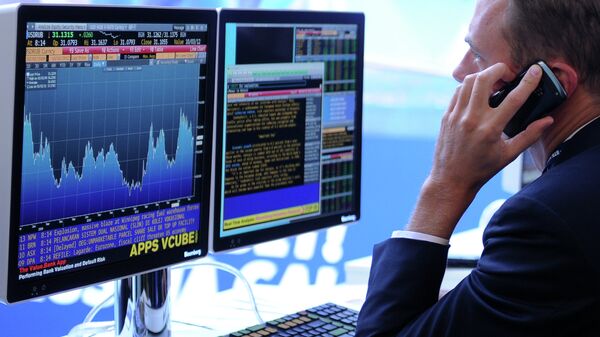MOSCOW, November 9 (RIA Novosti) — The US jobless data did not relief world markets of the further Fed tightening concern, but the dollar stumbled, while Europe and Russia are on a losing streak due to negative domestic factors, and Asia is still trying to adjust to Japan’s new-found competitive edge.
The US jobs report for October, published by the Bureau of Labor statistics yesterday, revealed 214,000 jobs have been added to the US economy, however, this is less than previously anticipated 231,000. Additionally, the unemployment rate fell to its lowest in six years, 5.8%. Analysts predicted earlier that the data would be optimistic enough for the Fed to hike interest rate before June 2015. While the actual data undershot the forecast, investors still anticipate further Fed action to tighten monetary policy. And they are almost certain that the Fed tightening will unravel at a faster pace than expected.
"It's hard to not bet on the economy, with the fundamentals looking like a full house: earnings are rock solid, we're growing at a nice pace and confidence is up," David Kelly of JPMorgan Funds in NY said as quoted by Reuters. "The number was slightly weaker than expected, but until we see real weakness or higher interest rates, we'll continue to be overweight on equities," he added.
American equities were flat, trading near record highs yesterday, with the three major indices indicating weekly gains. The Dow Jones industrial index added 0.11% (+19.46) to 17,573.93 points, the S&P 500 edged 0.03% up (+0.71) to 2,031.92 while the Nasdaq tech index slid 0.13% (-5.94), down to 4,632.53 points, according to the Bloomberg data. During the last week these indices rose 1.1%, 0.7% and 0.04%, respectively.
The dollar’s month-long rally stumbled somewhat on the less-than-expected payroll gains, as the USD index, an estimate of the dollar against a composite of several other currencies, rose to its highest since June 2010 88.19 points, and then slid 0.5% to 87.57.
European markets are expecting a decisive stimulus action, promised earlier this week by the ECB head Mario Draghi. The timing and volumes of the looming stimulus are still unknown and have left investors cautious. Meanwhile, several commercial banks reported weak demand for new loans within the Eurozone.
"Given the fact that we've had some weak results in terms of loan growth at French banks, with loan growth even negative at Credit Agricole, there are fears of a real slowdown happening at these banks," BESI analyst Shailesh Raikundlia said as quoted by Reuters.
The weaker-than-expected US payroll data have not added optimism in Europe. "The message seems to be that even if there was a slowdown in the US it was surely temporary," Antonin Jullier of Citi said as quoted by Reuters.
The EURO STOXX 50 was down by 1.20% and the pan-European FTSEurofist 300 slid by 0.6%, according to the data by Bloomberg.
In Russia, concerns over financial stability are rife after a 30% depreciation of the ruble from the year’s start. In order to support the ruble’s FX rate, Russia’s central bank said it is intending to boost its intervention. This decision came only a few days after the regulator announced they would float the exchange rate. The ruble was seemingly in the free-fall Friday morning, and some analysts were saying Russia is on the verge of a currency crisis, as reported by Reuters.
"The danger of additional central bank interventions hangs over the market. The market fears some kind of non-traditional measures, especially given the fact that people have already started besieging currency exchange booths," Dmitry Deev of Credit Suisse said as quoted by Reuters.
Oil prices have stabilized and even edged higher that same day, providing relief for the ruble. The Central bank announcement of its intension to intervene "at any moment" also contributed to the ruble’s stabilization. However, most analysts believe that the decline of the ruble was started by international sanctions levied at Russia for its alledged involvedment in the Ukraine crisis. Russian equities suffered on Friday as well, as the RTS Indes hit its lowest point in five years, slumping below 1,000 points.
Asian markets still experiencing the recent monetary injection by Bank of Japan, who increased their stimulus numbers by 60%. Foreign investors bought a record 7.21 bn Japanese futures during the past week, Reuters reports. "Our data only dates back to 2004, and it's the biggest in ten years for sure,” Jun Yunoki of Nomura Securities told Reuters.
Japan’s Nikkei 225 rose by 0.52% (+87.90) to 16,880.38 on the news, while Hong Kong’s Hang Seng index slid by 0.42% (-99.07) to 23,550.24.
Asian markets have shown that decisive stimulus action by national central banks proves efficient support for both domestic commercial activity and exports, providing a strong competitive edge to the economy. At this point, when the US is increasingly isolationist, at least economy-wise, they are gradually abandoning their role as a driver of growth for rest of world. As a consequence, Europe will need more ECB stimulus at least until the Transatlantic Trade and Investment Partnership (TTIP) is finalized, while some of Asian nations in the medium-term will rely on stimulus more than on benefits of deeper involvement in international trade. In Russia, growth is likely to resume as soon as its main trading partner, the EU, bolsters recovery, and the international pressure over political issues is eased.



